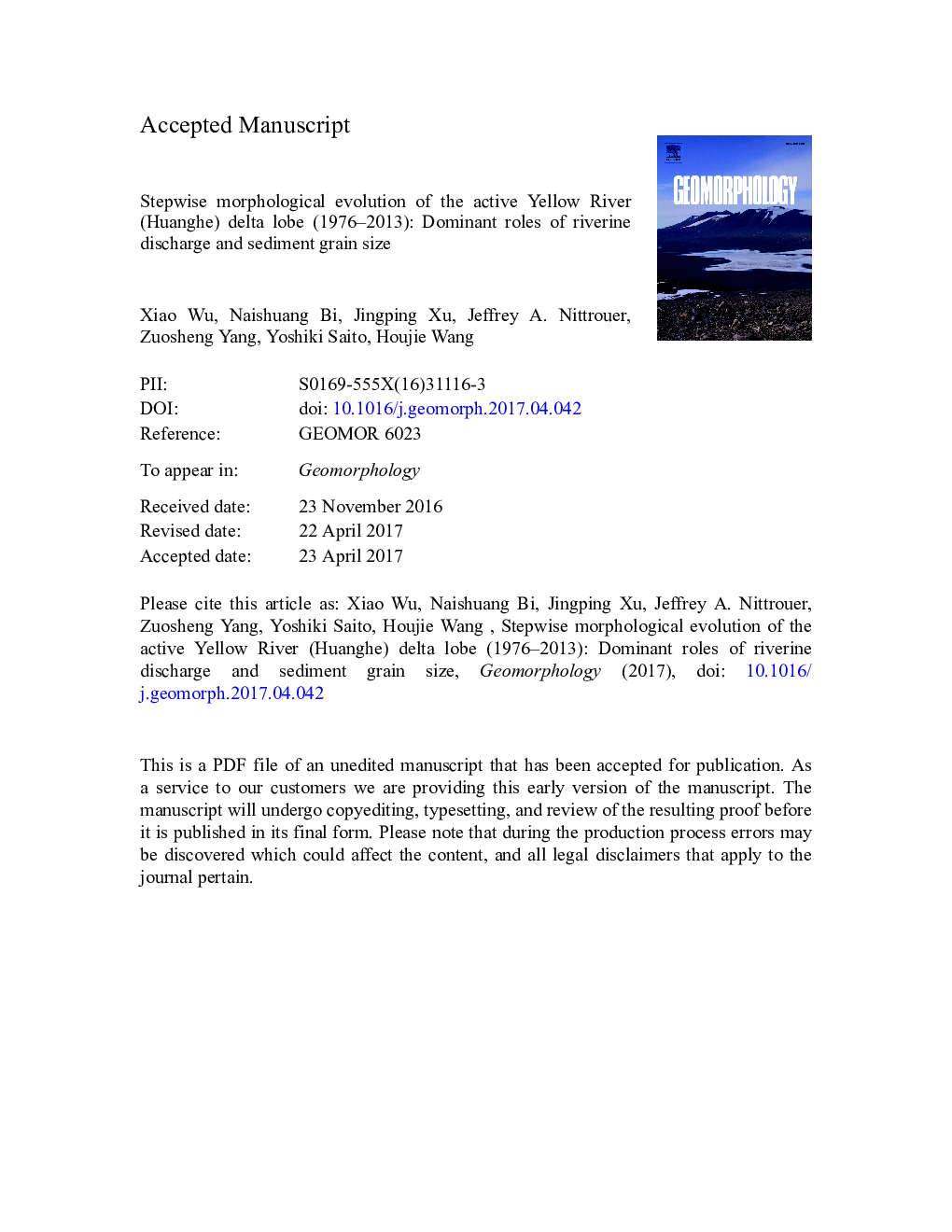| کد مقاله | کد نشریه | سال انتشار | مقاله انگلیسی | نسخه تمام متن |
|---|---|---|---|---|
| 5780888 | 1635357 | 2017 | 44 صفحه PDF | دانلود رایگان |
عنوان انگلیسی مقاله ISI
Stepwise morphological evolution of the active Yellow River (Huanghe) delta lobe (1976-2013): Dominant roles of riverine discharge and sediment grain size
دانلود مقاله + سفارش ترجمه
دانلود مقاله ISI انگلیسی
رایگان برای ایرانیان
کلمات کلیدی
موضوعات مرتبط
مهندسی و علوم پایه
علوم زمین و سیارات
فرآیندهای سطح زمین
پیش نمایش صفحه اول مقاله

چکیده انگلیسی
The presently active Yellow River (Huanghe) delta lobe has been formed since 1976 when the river was artificially diverted. The process and driving forces of morphological evolution of the present delta lobe still remain unclear. Here we examined the stepwise morphological evolution of the active Yellow River delta lobe including both the subaerial and the subaqueous components, and illustrated the critical roles of riverine discharge and sediment grain size in dominating the deltaic evolution. The critical sediment loads for maintaining the delta stability were also calculated from water discharge and sediment load measured at station Lijin, the last gauging station approximately 100 km upstream from the river mouth. The results indicated that the development of active delta lobe including both subaerial and subaqueous components has experienced four sequential stages. During the first stage (1976-1981) after the channel migration, the unchannelized river flow enhanced deposition within the channel and floodplain between Lijin station and the river mouth. Therefore, the critical sediment supply calculated by the river inputs obtained from station Lijin was the highest. However, the actual sediment load at this stage (0.84 Gt/yr) was more than twice of the critical sediment load (~ 0.35 Gt/yr) for sustaining the active subaerial area, which favored a rapid seaward progradation of the Yellow River subaerial delta. During the second stage (1981-1996), the engineering-facilitated channelized river flow and the increase in median grain size of suspended sediment delivered to the sea resulted in the critical sediment load for keeping the delta stability deceasing to 0.29 Gt/yr. The active delta lobe still gradually prograded seaward at an accretion rate of 11.9 km2/yr at this stage as the annual sediment load at Lijin station was 0.55 Gt/yr. From 1996 to 2002, the critical sediment load further decreased to 0.15 Gt/yr with the sediment grain size increased to 22.5 μm; however, the delta suffered net erosion because of the insufficient sediment supply (0.11 Gt/yr). In the most recent stage (2002 â 2013), the intensive scouring of the lower river channel induced by the dam regulation provided relatively coarser sediment, which effectively reduced the critical sediment load to 0.06 Gt/yr, much lower than the corresponding sediment load at Lijin station (~ 0.16 Gt/yr). Consequently, the subaerial Yellow River delta transitioned to a slight accretion phase. Overall, the evolution of the active Yellow River delta is highly correlated to riverine water and sediment discharge. The sediment supply for keeping the subaerial delta stability is inconstant and varying with the river channel morphology and sediment grain size. We conclude that the human-impacted riverine sediment discharge and grain-size composition play dominant roles in the stepwise morphological evolution of the active delta lobe.
ناشر
Database: Elsevier - ScienceDirect (ساینس دایرکت)
Journal: Geomorphology - Volume 292, 1 September 2017, Pages 115-127
Journal: Geomorphology - Volume 292, 1 September 2017, Pages 115-127
نویسندگان
Xiao Wu, Naishuang Bi, Jingping Xu, Jeffrey A. Nittrouer, Zuosheng Yang, Yoshiki Saito, Houjie Wang,